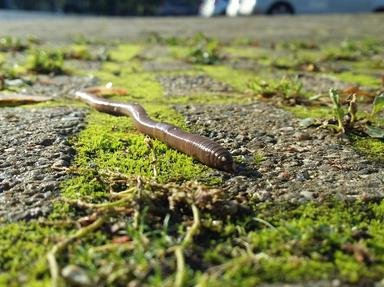Quiz Answer Key and Fun Facts
1. To sustain themselves, earthworms must guide their way through the soil using their powerful muscles. They gather nutrients by ingesting the soil and absorbing what they need into their bodies.
True or False: The two ends of the earthworm are both mouths which can equally ingest soil.
2. Earthworms have "furrows" or small folds that demarcate different smaller sections of their body. This has led to earthworms being classified as what type of worm?
3. Externally, earthworms have "setae", which are small hair-like bristles, though they are not composed of the same material as human hair. The setae help the earthworm anchor itself while feeding or mating. Found also in many insect wings/exoskeletons, what biological matter forms these structures?
4. When removed, what organ (contained within the red circle in the image here) would likely result in the earthworm's inability to control its direction and cause it to move continuously?
5. The earthworm has a closed circulatory system, with blood vessels that run along the body and a series of aortic arches that act as hearts. In this image, which of the following would be the blood vessels? (This might be a good time to click the image and get a closer look.)
6. These earthworms are mating and they don't have to worry about attracting the opposite sex since earthworms are hermaphroditic. As you can see in the picture, the thickened, bulging section of the worm is important for reproduction as it secretes a mucus that keeps the worms attached during copulation. It also secretes a sac that serves as a cocoon for the worm's eggs. What is this bulging section called?
7. This aged image shows the alimentary canal of the earthworm, which is basically a fancy way of saying the digestive tract. Which of the following pictured organs is responsible for grinding the earthworm's food (which serves the same purpose in many other animals as well)?
8. If you were to guess that this image is an oddly intricate illustration of worm feces, you would be right, drawn by none other than Charles Darwin. What are worm feces called?
9. This worm looks ready to dive back into the ground where it is more comfortable instead of sticking around in all this daylight. Yet, the worm has no eyes to see the light. How does the worm know to get out of the light?
10. This bird is working hard to eat this worm, but this worm is also working very hard to keep this from happening by contracting its powerful anterior muscles and digging in its setae into the soil. If this bird only manages to eat the very end of the earthworm, will the worm be able to regenerate its missing body?
Source: Author
trident
This quiz was reviewed by FunTrivia editor
guitargoddess before going online.
Any errors found in FunTrivia content are routinely corrected through our feedback system.

